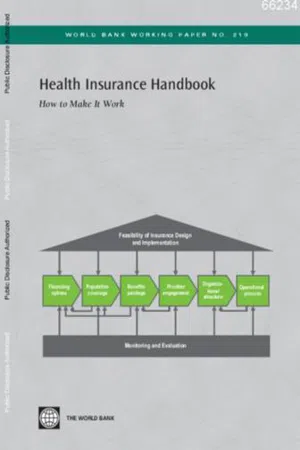
Health Insurance Handbook
How to Make It Work
- English
- PDF
- Available on iOS & Android
Health Insurance Handbook
How to Make It Work
About this book
Many countries that subscribe to the Millennium Development Goals (MDGs) have committed to ensuring access to basic health services for their citizens. Health insurance has been considered and promoted as the major financing mechanism to improve access to health services, as well as to provide financial risk protection. In Africa, several countries have already spent scarce time, money, and effort on health insurance initiatives. Ethiopia, Ghana, Kenya, Nigeria, Rwanda, and Tanzania are just a few of them. However, many of these schemes, both public and private, cover only a small proportion of the population, with the poor less likely to be covered. In fact, unless carefully designed to be pro-poor, health insurance can widen inequity as higher income groups are more likely to be insured and use health care services, taking advantage of their insurance coverage. The purpose of this handbook is to provide policy makers and health insurance designers with practical, action-oriented support that will deepen their understanding of health insurance concepts, help them identify design and implementation challenges, and define realistic steps for the development and scaling up of equitable, efficient, and sustainable health insurance schemes. The handbook takes policy makers and health insurance designers through a step-by-step series of considerations and tasks that need to be achieved. The handbook's philosophy is to not be dogmatic, ideological, or prescriptive. This handbook was prepared to be used in a six-day regional workshop. Clearly, health insurance design is an intensive political and technical process that takes much longer than six days. The expectation for the workshop is that by the end of the week, each team has a clear idea of next steps that they could take back home to engage other stakeholders and move toward scaling up and improving the performance of health insurance in their country.
Frequently asked questions
- Essential is ideal for learners and professionals who enjoy exploring a wide range of subjects. Access the Essential Library with 800,000+ trusted titles and best-sellers across business, personal growth, and the humanities. Includes unlimited reading time and Standard Read Aloud voice.
- Complete: Perfect for advanced learners and researchers needing full, unrestricted access. Unlock 1.4M+ books across hundreds of subjects, including academic and specialized titles. The Complete Plan also includes advanced features like Premium Read Aloud and Research Assistant.
Please note we cannot support devices running on iOS 13 and Android 7 or earlier. Learn more about using the app.
Information
Table of contents
- Contents
- Foreword
- Preface
- Acknowledgments
- Acronyms and Abbreviations
- 1. Introduction
- 2. Design Element 1: Feasibility of Health Insurance
- 3. Design Element 2: Choice of Financing Mechanisms
- 4. Design Element 3: Population Coverage
- 5. Design Element 4: Benefits Packages and Cost Containment
- 6. Design Element 5: Engagement, Selection, and Payment of Health Care Providers
- 7. Design Element 6: Organizational Structure
- 8. Design Element 7: Operationalizing Health Insurance
- 9. Design Element 8: Monitoring and Evaluation of Health Insurance Schemes
- Notes
- Appendixes
- References
- Recently Published
- Forthcoming Publications
- Boxes
- Figures
- Tables